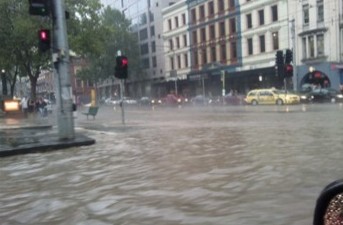
By Erin Fairbanks
Melbourne is a coastal city sharing a border with Port Phillips Bay and home to three major waterways, the Yarra and Maribymong Rivers and the Moonee Ponds Creek. Water conservation and storm water management are major city priorities but are overseen by separate programs at both state and local government levels, which can hinder coordination. Climate change and population growth are expected to greatly impact the city’s already stressed water supply. What follows is an assessment of climate risks (Mehrotra et al., 2009) facing the water sector in Melbourne, and interventions that can be made to address these risks.
Managing land use under population growth is a critical issue for the city. Melbourne’s population is expected to increase at a rate of 3% a year, which would make it the largest city in Australia by 2030 (Australian Bureau of Statistics, 2011b). The city housing stock grew by 2000 from 2008-09, and this trend can be expected to continue (City of Melbourne, 2010). Decreases in water catchment areas and pollution run off from construction sites are both serious concerns. Population increases can be expected to stress the water system at all levels.
The city has experienced a decrease in precipitation for the past 11 years, and by 2030, average rainfall is expected to decrease by 7% with a 21% decrease projected by 2070 (City of Melbourne, 2009). This decrease in precipitation will be further compounded by increases in evaporation due to projected temperature increases. As a result, average stream flow will likely be reduced by 3% to 11% within the next 10 years (City of Melbourne, 2009). While overall precipitation is projected to decline, extreme precipitation events are expected to grow more frequent and severe. These extreme events will overwhelm the city’s aging storm water system and leave it vulnerable to flooding (Melbourne Water, 2011b). Picking up pollutants from roadways, construction sites and litter, storm water run off will further threaten waterways and ecosystems already stressed by reduced water flow. Projected sea level rise will also make the city more prone to flooding during extreme weather events. In addition, sea level rise could lead to the salinization of fresh waterways, further compromising the health of the city’s waterways and water supply.
The city’s primary response has been to focus on reduced consumption across sectors; baseline measures were set in 2000 with municipal usage accounting for 6.6% of total water usage, residential usage at 21.7% and industrial usage at 71.6% (City of Melbourne, 2009). Primary reduction techniques involve the installation of water efficient fittings or utilities, education, and exploration of alternative or drought-tolerant plant species, as 82% of municipal water usage is for management of parks and gardens. Additional efforts have been made to explore decentralizing the water supply through rainwater catchment techniques, river to reservoir pipelines, desalinization plants, and a preliminary look at grey water usage (Melbourne Water, 2011a).
Three institutional mechanisms to achieve co-benefits of adaptation and mitigation are: First, development polices that incentivize higher density, allowing for reduction in water transport, and creating opportunities for building specific water conservation strategies and protecting the catchment area. Second, private sector support will be critical to Melbourne’s ability to meet growing water needs and facilitate conservation work through the provision of innovative technologies and active participation in existing reduction mechanisms. Third, effective collection of storm water is an opportunity to enhance the existing water supply, prevent water pollution, and avoid flooding. Storm water collection policies should focus on low energy systems and target the private sector.
This article is a product of Professor Shagun Mehrotra’s Climate Change and Cities class. Views expressed are entirely those of the individual author.
References
Australian Bureau of Statistics. (2011b). 3218.0 – Regional population growth, Australia, 2009-10. Retrieved 10/5, 2011, from http://www.abs.gov.au/ausstats/abs@.nsf/Products/3218.0~2009-10~Main+Features~Victoria?OpenDocument
Blake, R., Grimm, A., Ichinose T., Horton, R., Gaffin, S., Jiong, S., Bader, D., Cecil, L. D. (2011). Urban climate: Processes, trends, and projections. In Rosenzweig, C., Solecki, W. D., Hammer, S. A., Mehrotra, S. (Ed.), Climate change and cities: First assessment report of the urban climate change research network (pp. 43-81). Cambridge, UK: Cambridge University Press.
Consulting Pty Ltd. (2011b). City of Melbourne population forecasts. Retrieved 10/05, 2011, from http://forecast2.id.com.au/Default.aspx?id=128&pg=5000
City of Melbourne. (2009). Climate change adaptation strategy. No. 60040845). Retrieved 10/5) from http://www.melbourne.vic.gov.au/AboutCouncil/PlansandPublications/strategies/Documents/climate_change_adaptation_strategy.PDF
City of Melbourne. (2010). Analysis of Population and Housing in Melbourne Local Government Area 2001 to 2009. Retrieved 11/19, fromhttp://www.melbourne.vic.gov.au/AboutMelbourne/Statistics/Pages/Population.aspx
City of Melbourne. (2009). Total Watermark: City as Catchment. Retrieved 11/4, 2011 fromhttp://www.melbourne.vic.gov.au/Environment/WhatCouncilisDoing/Pages/CityCatchment.aspx
Mehrotra, S., C.E. Natenzon, A. Omojola, R. Folorunsho, J. Gilbride & C. Rosenzweig. (2009). Framework for city climate risk assessment. Washington, DC: World Bank.
Melbourne Water. (2011a). Melbourne Water homepage. Retrieved 10/10/2011 from http://melbournewater.com.au
Melbourne Water. (2011b). Flood management and drainage strategy. Retrieved 10/9, 2011, from http://www.melbournewater.com.au/content/publications/reports/flood_management_and_drainage_strategy.asp